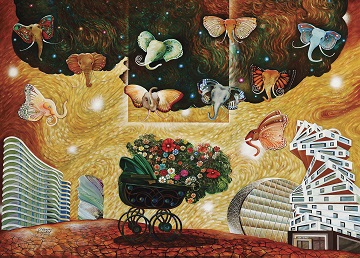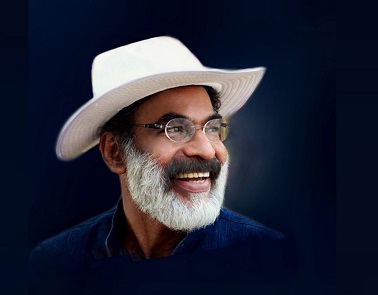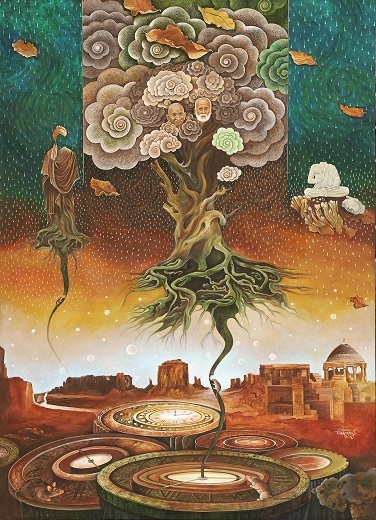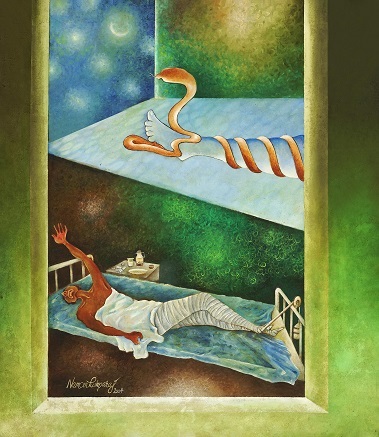DYSTOPIA, an exhibition of paintings and sculptures, at Durbar Hall, Cochin in Kerala by Mr. Nemom Pushparaj, artist, writer, art director, and filmmaker, reflects the concerns of a sensitive, humane, thinking, and caring citizen of India.
As an official in the Department of Culture, Kerala, Pushparaj’s contributions have been valuable. As the Chairman of Lalithakala Academy, he countered the gloomy COVID era by allowing artists to work from home toward the collection of the Academy. As an artist, he has showcased his works both in national and international exhibitions.
The theme of DYSTOPIA is ‘the chaotic hell of our existential reality’.The unique pictorial idiom stemmed from his fears and fantasies during a prolonged bedridden existence in his youth. Johny M.L, the art-critic calls it ‘Meta Modern’. Rooted in surrealism a distinctive, “hyper-realistic painting style,” has evolved in the course of his journey as an artist. This exclusive style, like a cartoon, drives the viewer into a thinking mode.
As I moved along, from painting to painting, my heartbeat became louder, creating an anxiety that roused memories of India’s mythical times and historical past, which pushed us onto our own lifetime. The subject matter and style amalgamate to highlight the bitter truths that lay hidden in the aberrations of our present-day realities.
Justice in India, both social and political, is a theme that the artist brings under scrutiny. The theme of injustice that has defeated, the people of the subcontinent from mythical times onwards, is an ironical reminder of where we stand in our socio-political realities now. The artist brings them under his lens in DENIAL OF JUSTICE.
The disrobed woman, from Draupati of the epic days to our own times, is still punished by the powers that rule. That the piece of cloth which smothers her, is from the Tricolored flag of free India deepens the irony. The balance, the symbol of justice, is placed on the chessboard of a political game controlled by a Vulture, the emblem of Imperial Rome. The entire canvas glows in flaming red, the color of blood, of the female body, a raging red of fire that will destroy everything. Where is modernity, and equality, and where is justice?
The situation in India is an echo of what happens all over the world to suppress women, where rape is a weapon in the hand of the male ego and is an afterthought that flows like tears in human hearts.




‘TRIAL’, is another painting that questions the theme of justice in the present-day light of an independent judiciary of liberated India where ‘justice delayed is justice denied’.The vulture, the same old symbol is waiting for the dead corpse. The classical blindfolded Justice is a different figure now. From her headless trunk sprouts a potted plant with flowers. Justice is transformed as the wheel of Time has rolled on. The judge mediates between her and ticking Time, as people have died of injustice. The deep, stark brown color deepens into gray and black, as fire smolders inside.
Environmental issues are another theme that the artist has taken up in his quest for sanity in the present times. Modern living spaces aspiring to touch the sky, destroy the green around them, especially in a populous country like India. That, it turns everything upside down, is ironically cast in OAISIS. The vast green land has been changed into a harsh burning barren region. The skyscrapers have turned the land into a desert where her green cover is bundled into a push cart, on a desolate terrain. Here, in this desert, we see elephants turned into butterflies fluttering day and night. Our ancestors, the aborigines are sidelined and victimized; their livelihood, art, and culture are negated. The artist pays a tribute to our ancestors: their way of life, their art by painting their abode and life in harmony with Nature, a way of life that Mother Earth nurtured, as in MARGINALISED, and THE VICTIM.
Now, on this deserted, barren land live the aspiring people of India in their Skyscrapers, headless people who misuse freedom. In PROGRESS we see a headless man with a sword in hand, his limbs painted in the colors of our flag, walk over the national flag. In the background is shown how we have distorted the course of running water for our pleasure. For, we are led by headless leaders, as shown in THE LEADER. For them only the Chair matters, the chair is the symbol of power. Beyond the curtained window, hang dead bodies, his victims. The red color of the chair and the wall, indicate the blood stain of those killed for grabbing power.


A critical analysis of the dystopian reality throws light on the hidden factors. The magnificence of India’s culture, according to the artist, lay in its spiritual aura from the time of the Budha in the subcontinent, transformed by Vivekananda for the West, streamlined and by the Gandhian political philosophy, and reoriented by social reformers like Sree Narayan Guru for Keralites. Time has uprooted this tree of progress as pictured in DEVALUATION. The dominating brown color against green and white reveals how dark and dull is our time. The builders of real India are for sale now, as SALESMAN shows what has happened to our past glory. Starting with the Hindu God, Brahma, the Buddha, Christ, Marx, and Gandhiji, all are for sale, just for decorations on the wall.
HUNTING shows what happens in our parliament today. Divisive politics on religious lines kill people. The uprooted tree with its one strong root is a repeated image. The gnawing rat will finish it any time. The clock below says it is a matter of time. Beyond stretches the panorama of an excavated archaeological site, the remnants of a celebrated past, a painful indicator of the present reality.
PANDEMIC is a reality check of what happened in our populous country that is India, in recent times when the entire world was enveloped in helplessness. Masks, the symbol for Covid submerges the entire land as dead bodies float and fly where healthcare workers push coffins, and Death waits with its ferry to cross over. Ironically, light-colors highlight bleak reality. This is the one painting where the helplessness of the entire country is etched in pain without irony or sarcasm.


There are two pieces named ‘DYSTOPIA’ that examine the idea of dystopia, one a painting and the other an elegant handiwork executed in mixed media. The painting reveals the subconscious mind that points to mythical and historical stories of cruelty and deceit, which fuel the perverted opportunists to grab power, not only in India but all over the world.
Second, the sculpture in mixed media shows the mind of a so-called successful man of the present, living among us. Here is the figure of a headless man seated on a money bag. Through its broken corner peeps the Indian currency note with the picture of Gandhiji. The irony deepens as we see the seated, headless figure grab hold of an advocate, a doctor, and a common man. The work exposes the unease of money controlling everything from law to healthcare. Nobody is spared from the depressing reality around us. Yet, hope is not far away. Surrounding the nucleus are people fighting back. The artist looks forward to a time that will heal the wounds inflicted since the Emergency to the present day on our body politic.
Yet, despite the harsh realities, hope rises as we stand in front of the engraving in Bronze, PROGRESS, a dream full of optimism. Of all beings on Earth, only humans are concerned with progress. Human history has been a march of progress. Yes, wait, the quixotic humor of the artist is seen as we come to the PROCESSION. The traditional biting humor of Chakyarkoothu of Kerala comes alive as Nemom Pushparaj displays his PROCESSION that carries the Donkey-Ruler not just in India but in different parts of the world.
The SHEPERD series, with its broken clock, cows, calves, and flute, near a waterbody full of lotus waiting, is ironically juxtaposed with the man lying buried in a time machine reminding us of Bhishma, of the Mahabharatha on his bed of arrows. Hope, rejuvenating hope, springs as the subcontinent waits for its shepherd. A lyrically cast painting with the dream of hope, is a tribute to the artist’s mind, his love of life, and his trust in man. In his own words, “I want to build in my works a befitting monument for those who have been wounded and defeated”, and hope is the unseen thread that runs through like a string all the way through his works.
by Padma Jayaraj
Also, Read
World Tourism Day returns to focus on the future
Watch on Youtube
Follow and connect with us on Facebook Youtube Twitter
